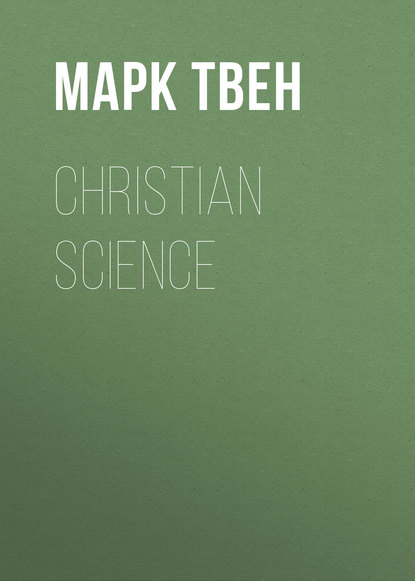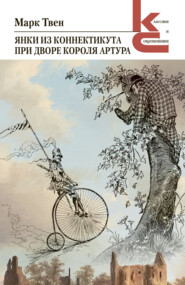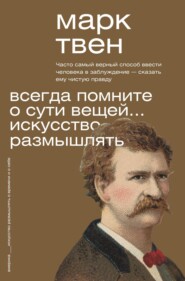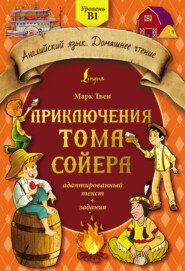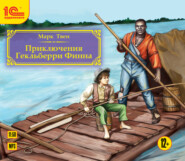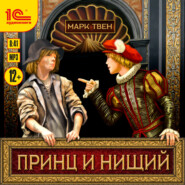По всем вопросам обращайтесь на: info@litportal.ru
(©) 2003-2025.
✖
Christian Science
Настройки чтения
Размер шрифта
Высота строк
Поля
I was obliged to do this because I had a stomach-ache and a cold in the head, and I was not willing to trust these things any longer in the hands of a woman whom I did not know, and whose ability to successfully treat mere disease I had lost all confidence. My position was justified by the fact that the cold and the ache had been in her charge from the first, along with the fractures, but had experienced not a shade of relief; and, indeed, the ache was even growing worse and worse, and more and more bitter, now, probably on account of the protracted abstention from food and drink.
The horse-doctor came, a pleasant man and full of hope and professional interest in the case. In the matter of smell he was pretty aromatic – in fact, quite horsy – and I tried to arrange with him for absent treatment, but it was not in his line, so, out of delicacy, I did not press it. He looked at my teeth and examined my hock, and said my age and general condition were favorable to energetic measures; therefore he would give me something to turn the stomach-ache into the botts and the cold in the head into the blind staggers; then he should be on his own beat and would know what to do. He made up a bucket of bran-mash, and said a dipperful of it every two hours, alternated with a drench with turpentine and axle-grease in it, would either knock my ailments out of me in twenty-four hours, or so interest me in other ways as to make me forget they were on the premises. He administered my first dose himself, then took his leave, saying I was free to eat and drink anything I pleased and in any quantity I liked. But I was not hungry any more, and did not care for food.
I took up the Christian Science book and read half of it, then took a dipperful of drench and read the other half. The resulting experiences were full of interest and adventure. All through the rumblings and grindings and quakings and effervescings accompanying the evolution of the ache into the botts and the cold into the blind staggers I could note the generous struggle for mastery going on between the mash and the drench and the literature; and often I could tell which was ahead, and could easily distinguish the literature from the others when the others were separate, though not when they were mixed; for when a bran-mash and an eclectic drench are mixed together they look just like the Apodictical Principle out on a lark, and no one can tell it from that. The finish was reached at last, the evolutions were complete, and a fine success, but I think that this result could have been achieved with fewer materials. I believe the mash was necessary to the conversion of the stomach-ache into the botts, but I think one could develop the blind staggers out of the literature by itself; also, that blind staggers produced in this way would be of a better quality and more lasting than any produced by the artificial processes of the horse-doctor.
For of all the strange and frantic and incomprehensible and uninterpretable books which the imagination of man has created, surely this one is the prize sample. It is written with a limitless confidence and complacency, and with a dash and stir and earnestness which often compel the effects of eloquence, even when the words do not seem to have any traceable meaning. There are plenty of people who imagine they understand the book; I know this, for I have talked with them; but in all cases they were people who also imagined that there were no such things as pain, sickness, and death, and no realities in the world; nothing actually existent but Mind. It seems to me to modify the value of their testimony. When these people talk about Christian Science they do as Mrs. Fuller did: they do not use their own language, but the book’s; they pour out the book’s showy incoherences, and leave you to find out later that they were not originating, but merely quoting; they seem to know the volume by heart, and to revere it as they would a Bible – another Bible, perhaps I ought to say. Plainly the book was written under the mental desolations of the Third Degree, and I feel sure that none but the membership of that Degree can discover meanings in it. When you read it you seem to be listening to a lively and aggressive and oracular speech delivered in an unknown tongue, a speech whose spirit you get but not the particulars; or, to change the figure, you seem to be listening to a vigorous instrument which is making a noise which it thinks is a tune, but which, to persons not members of the band, is only the martial tooting of a trombone, and merrily stirs the soul through the noise, but does not convey a meaning.
The book’s serenities of self-satisfaction do almost seem to smack of a heavenly origin – they have no blood-kin in the earth. It is more than human to be so placidly certain about things, and so finely superior, and so airily content with one’s performance. Without ever presenting anything which may rightfully be called by the strong name of Evidence, and sometimes without even mentioning a reason for a deduction at all, it thunders out the startling words, “I have Proved” so and so. It takes the Pope and all the great guns of his Church in battery assembled to authoritatively settle and establish the meaning of a sole and single unclarified passage of Scripture, and this at vast cost of time and study and reflection, but the author of this work is superior to all that: she finds the whole Bible in an unclarified audition, and at small expense of time and no expense of mental effort she clarifies it from lid to lid, reorganizes and improves the meanings, then authoritatively settles and establishes them with formulas which you cannot tell from “Let there be light!” and “Here you have it!” It is the first time since the dawn-days of Creation that a Voice has gone crashing through space with such placid and complacent confidence and command.
[January, 1903. The first reading of any book whose terminology is new and strange is nearly sure to leave the reader in a bewildered and sarcastic state of mind. But now that, during the past two months, I have, by diligence gained a fair acquaintanceship with Science and Health technicalities, I no longer find the bulk of that work hard to understand. – M. T.]
P.S. The wisdom harvested from the foregoing thoughts has already done me a service and saved me a sorrow. Nearly a month ago there came to me from one of the universities a tract by Dr. Edward Anthony Spitzka on the “Encephalic Anatomy of the Races.” I judged that my opinion was desired by the university, and I was greatly pleased with this attention and wrote and said I would furnish it as soon as I could. That night I put my plodding and disheartening Christian Science mining aside and took hold of the matter. I wrote an eager chapter, and was expecting to finish my opinion the next day, but was called away for a week, and my mind was soon charged with other interests. It was not until to-day, after the lapse of nearly a month, that I happened upon my Encephalic chapter again. Meantime, the new wisdom had come to me, and I read it with shame. I recognized that I had entered upon that work in far from the right temper – far from the respectful and judicial spirit which was its due of reverence. I had begun upon it with the following paragraph for fuel:
“FISSURES OF THE PARIETAL AND OCCIPITAL LOBES (LATERAL SURFACE). – The Postcentral Fissural Complex – In this hemicerebrum, the postcentral and subcentral are combined to form a continuous fissure, attaining a length of 8.5 cm. Dorsally, the fissure bifurcates, embracing the gyre indented by the caudal limb of the paracentral. The caudal limb of the postcentral is joined by a transparietal piece. In all, five additional rami spring from the combined fissure. A vadum separates it from the parietal; another from the central.”
It humiliates me, now, to see how angry I got over that; and how scornful. I said that the style was disgraceful; that it was labored and tumultuous, and in places violent, that the treatment was involved and erratic, and almost, as a rule, bewildering; that to lack of simplicity was added a lack of vocabulary; that there was quite too much feeling shown; that if I had a dog that would get so excited and incoherent over a tranquil subject like Encephalic Anatomy I would not pay his tax; and at that point I got excited myself and spoke bitterly of these mongrel insanities, and said a person might as well try to understand Science and Health.
[I know, now, where the trouble was, and am glad of the interruption that saved me from sending my verdict to the university. It makes me cold to think what those people might have thought of me. – M. T.]
CHAPTER IV
No one doubts – certainly not I – that the mind exercises a powerful influence over the body. From the beginning of time, the sorcerer, the interpreter of dreams, the fortune-teller, the charlatan, the quack, the wild medicine-man, the educated physician, the mesmerist, and the hypnotist have made use of the client’s imagination to help them in their work. They have all recognized the potency and availability of that force. Physicians cure many patients with a bread pill; they know that where the disease is only a fancy, the patient’s confidence in the doctor will make the bread pill effective.
Faith in the doctor. Perhaps that is the entire thing. It seems to look like it. In old times the King cured the king’s evil by the touch of the royal hand. He frequently made extraordinary cures. Could his footman have done it? No – not in his own clothes. Disguised as the King, could he have done it? I think we may not doubt it. I think we may feel sure that it was not the King’s touch that made the cure in any instance, but the patient’s faith in the efficacy of a King’s touch. Genuine and remarkable cures have been achieved through contact with the relics of a saint. Is it not likely that any other bones would have done as well if the substitution had been concealed from the patient? When I was a boy a farmer’s wife who lived five miles from our village had great fame as a faith-doctor – that was what she called herself. Sufferers came to her from all around, and she laid her hand upon them and said, “Have faith – it is all that is necessary,” and they went away well of their ailments. She was not a religious woman, and pretended to no occult powers. She said that the patient’s faith in her did the work. Several times I saw her make immediate cures of severe toothaches. My mother was the patient. In Austria there is a peasant who drives a great trade in this sort of industry, and has both the high and the low for patients. He gets into prison every now and then for practising without a diploma, but his business is as brisk as ever when he gets out, for his work is unquestionably successful and keeps his reputation high. In Bavaria there is a man who performed so many great cures that he had to retire from his profession of stage-carpentering in order to meet the demand of his constantly increasing body of customers. He goes on from year to year doing his miracles, and has become very rich. He pretends to no religious helps, no supernatural aids, but thinks there is something in his make-up which inspires the confidence of his patients, and that it is this confidence which does the work, and not some mysterious power issuing from himself.
Within the last quarter of a century, in America, several sects of curers have appeared under various names and have done notable things in the way of healing ailments without the use of medicines. There are the Mind Cure the Faith Cure, the Prayer Cure, the Mental Science Cure, and the Christian-Science Cure; and apparently they all do their miracles with the same old, powerful instrument – the patient’s imagination. Differing names, but no difference in the process. But they do not give that instrument the credit; each sect claims that its way differs from the ways of the others.
They all achieve some cures, there is no question about it; and the Faith Cure and the Prayer Cure probably do no harm when they do no good, since they do not forbid the patient to help out the cure with medicines if he wants to; but the others bar medicines, and claim ability to cure every conceivable human ailment through the application of their mental forces alone. There would seem to be an element of danger here. It has the look of claiming too much, I think. Public confidence would probably be increased if less were claimed.
The Christian Scientist was not able to cure my stomach-ache and my cold; but the horse-doctor did it. This convinces me that Christian Science claims too much. In my opinion it ought to let diseases alone and confine itself to surgery. There it would have everything its own way.
The horse-doctor charged me thirty kreutzers, and I paid him; in fact, I doubled it and gave him a shilling. Mrs. Fuller brought in an itemized bill for a crate of broken bones mended in two hundred and thirty-four places – one dollar per fracture.
“Nothing exists but Mind?”
“Nothing,” she answered. “All else is substanceless, all else is imaginary.”
I gave her an imaginary check, and now she is suing me for substantial dollars. It looks inconsistent.
CHAPTER V
Let us consider that we are all partially insane. It will explain us to each other; it will unriddle many riddles; it will make clear and simple many things which are involved in haunting and harassing difficulties and obscurities now.
Those of us who are not in the asylum, and not demonstrably due there, are nevertheless, no doubt, insane in one or two particulars. I think we must admit this; but I think that we are otherwise healthy-minded. I think that when we all see one thing alike, it is evidence that, as regards that one thing, our minds are perfectly sound. Now there are really several things which we do all see alike; things which we all accept, and about which we do not dispute. For instance, we who are outside of the asylum all agree that water seeks its level; that the sun gives light and heat; that fire consumes; that fog is damp; that six times six are thirty-six, that two from ten leaves eight; that eight and seven are fifteen. These are, perhaps, the only things we are agreed about; but, although they are so few, they are of inestimable value, because they make an infallible standard of sanity. Whosoever accepts them him we know to be substantially sane; sufficiently sane; in the working essentials, sane. Whoever disputes a single one of them him we know to be wholly insane, and qualified for the asylum.
Very well, the man who disputes none of them we concede to be entitled to go at large. But that is concession enough. We cannot go any further than that; for we know that in all matters of mere opinion that same man is insane – just as insane as we are; just as insane as Shakespeare was. We know exactly where to put our finger upon his insanity: it is where his opinion differs from ours.
That is a simple rule, and easy to remember. When I, a thoughtful and unblessed Presbyterian, examine the Koran, I know that beyond any question every Mohammedan is insane; not in all things, but in religious matters. When a thoughtful and unblessed Mohammedan examines the Westminster Catechism, he knows that beyond any question I am spiritually insane. I cannot prove to him that he is insane, because you never can prove anything to a lunatic – for that is a part of his insanity and the evidence of it. He cannot prove to me that I am insane, for my mind has the same defect that afflicts his. All Democrats are insane, but not one of them knows it; none but the Republicans and Mugwumps know it. All the Republicans are insane, but only the Democrats and Mugwumps can perceive it. The rule is perfect: in all matters of opinion our adversaries are insane. When I look around me, I am often troubled to see how many people are mad. To mention only a few:
The Atheist, The Theosophists, The Infidel, The Swedenborgians, The Agnostic, The Shakers, The Baptist, The Millerites, The Methodist, The Mormons, The Christian Scientist, The Laurence Oliphant Harrisites, The Catholic, and the 115 Christian sects, the Presbyterian excepted, The Grand Lama’s people, The Monarchists, The Imperialists, The 72 Mohammedan sects, The Democrats, The Republicans (but not the Mugwumps), The Buddhist, The Blavatsky-Buddhist, The Mind-Curists, The Faith-Curists, The Nationalist, The Mental Scientists, The Confucian, The Spiritualist, The Allopaths, The 2000 East Indian sects, The Homeopaths, The Electropaths, The Peculiar People, The —
But there’s no end to the list; there are millions of them! And all insane; each in his own way; insane as to his pet fad or opinion, but otherwise sane and rational. This should move us to be charitable towards one another’s lunacies. I recognize that in his special belief the Christian Scientist is insane, because he does not believe as I do; but I hail him as my mate and fellow, because I am as insane as he insane from his point of view, and his point of view is as authoritative as mine and worth as much. That is to say, worth a brass farthing. Upon a great religious or political question, the opinion of the dullest head in the world is worth the same as the opinion of the brightest head in the world – a brass farthing. How do we arrive at this? It is simple. The affirmative opinion of a stupid man is neutralized by the negative opinion of his stupid neighbor no decision is reached; the affirmative opinion of the intellectual giant Gladstone is neutralized by the negative opinion of the intellectual giant Newman – no decision is reached. Opinions that prove nothing are, of course, without value any but a dead person knows that much. This obliges us to admit the truth of the unpalatable proposition just mentioned above – that, in disputed matters political and religious, one man’s opinion is worth no more than his peer’s, and hence it followers that no man’s opinion possesses any real value. It is a humbling thought, but there is no way to get around it: all opinions upon these great subjects are brass-farthing opinions.
It is a mere plain, simple fact – as clear and as certain as that eight and seven make fifteen. And by it we recognize that we are all insane, as concerns those matters. If we were sane, we should all see a political or religious doctrine alike; there would be no dispute: it would be a case of eight and seven – just as it is in heaven, where all are sane and none insane. There there is but one religion, one belief; the harmony is perfect; there is never a discordant note.
Under protection of these preliminaries, I suppose I may now repeat without offence that the Christian Scientist is insane. I mean him no discourtesy, and I am not charging – nor even imagining – that he is insaner than the rest of the human race. I think he is more picturesquely insane than some of us. At the same time, I am quite sure that in one important and splendid particular he is much saner than is the vast bulk of the race.
Why is he insane? I told you before: it is because his opinions are not ours. I know of no other reason, and I do not need any other; it is the only way we have of discovering insanity when it is not violent. It is merely the picturesqueness of his insanity that makes it more interesting than my kind or yours. For instance, consider his “little book”; the “little book” exposed in the sky eighteen centuries ago by the flaming angel of the Apocalypse, and handed down in our day to Mrs. Mary Baker G. Eddy, of New Hampshire, and translated by her, word for word, into English (with help of a polisher), and now published and distributed in hundreds of editions by her at a clear profit per volume, above cost, of seven hundred per cent.! – a profit which distinctly belongs to the angel of the Apocalypse, and let him collect it if he can; a “little book” which the C.S. very frequently calls by just that name, and always enclosed in quotation-marks to keep its high origin exultantly in mind; a “little book” which “explains” and reconstructs and new-paints and decorates the Bible, and puts a mansard roof on it and a lightning-rod and all the other modern improvements; a “little book” which for the present affects to travel in yoke with the Bible and be friendly to it, and within half a century will hitch the Bible in the rear and thenceforth travel tandem, itself in the lead, in the coming great march of Christian Scientism through the Protestant dominions of the planet.
CHAPTER VI
“Hungry ones throng to hear the Bible read in connection with the text-book of Christian Science, Science and Health, with Key to the Scriptures, by Mary Baker G. Eddy. These are our only preachers. They are the word of God.” “Christian Science Journal”, October, 1898.
Is that picturesque? A lady has told me that in a chapel of the Mosque in Boston there is a picture or image of Mrs. Eddy, and that before it burns a never-extinguished light. Is that picturesque? How long do you think it will be before the Christian Scientist will be worshipping that picture or image and praying to it? How long do you think it will be before it is claimed that Mrs. Eddy is a Redeemer, a Christ, and Christ’s equal? Already her army of disciples speak of her reverently as “Our Mother.”
How long will it be before they place her on the steps of the Throne beside the Virgin – and, later, a step higher? First, Mary the Virgin and Mary the Matron; later, with a change of precedence, Mary the Matron and Mary the Virgin. Let the artist get ready with his canvas and his brushes; the new Renaissance is on its way, and there will be money in altar-canvases – a thousand times as much as the Popes and their Church ever spent on the Old Masters; for their riches were poverty as compared with what is going to pour into the treasure-chest of the Christian-Scientist Papacy by-and-by, let us not doubt it. We will examine the financial outlook presently and see what it promises. A favorite subject of the new Old Master will be the first verse of the twelfth chapter of Revelation – a verse which Mrs. Eddy says (in her Annex to the Scriptures) has “one distinctive feature which has special reference to the present age” – and to her, as is rather pointedly indicated:
“And there appeared a great wonder in heaven; a woman clothed with the sun, and the moon under her feet,” etc.
The woman clothed with the sun will be a portrait of Mrs. Eddy.
Is it insanity to believe that Christian-Scientism is destined to make the most formidable show that any new religion has made in the world since the birth and spread of Mohammedanism, and that within a century from now it may stand second to Rome only, in numbers and power in Christendom?
If this is a wild dream it will not be easy to prove it so just yet, I think. There seems argument that it may come true. The Christian-Science “boom,” proper, is not yet five years old; yet already it has two hundred and fifty churches.
It has its start, you see, and it is a phenomenally good one. Moreover, it is latterly spreading with a constantly accelerating swiftness. It has a better chance to grow and prosper and achieve permanency than any other existing “ism”; for it has more to offer than any other. The past teaches us that in order to succeed, a movement like this must not be a mere philosophy, it must be a religion; also, that it must not claim entire originality, but content itself with passing for an improvement on an existing religion, and show its hand later, when strong and prosperous – like Mohammedanism.
Next, there must be money – and plenty of it.
Next, the power and authority and capital must be concentrated in the grip of a small and irresponsible clique, with nobody outside privileged to ask questions or find fault.
Next, as before remarked, it must bait its hook with some new and attractive advantages over the baits offered by its competitors. A new movement equipped with some of these endowments – like spiritualism, for instance may count upon a considerable success; a new movement equipped with the bulk of them – like Mohammedanism, for instance – may count upon a widely extended conquest. Mormonism had all the requisites but one it had nothing new and nothing valuable to bait with. Spiritualism lacked the important detail of concentration of money and authority in the hands of an irresponsible clique.
The above equipment is excellent, admirable, powerful, but not perfect. There is yet another detail which is worth the whole of it put together and more; a detail which has never been joined (in the beginning of a religious movement) to a supremely good working equipment since the world began, until now: a new personage to worship. Christianity had the Saviour, but at first and for generations it lacked money and concentrated power. In Mrs. Eddy, Christian Science possesses the new personage for worship, and in addition – here in the very beginning – a working equipment that has not a flaw in it. In the beginning, Mohammedanism had no money; and it has never had anything to offer its client but heaven – nothing here below that was valuable. In addition to heaven hereafter, Christian Science has present health and a cheerful spirit to offer; and in comparison with this bribe all other this-world bribes are poor and cheap. You recognize that this estimate is admissible, do you not?
To whom does Bellamy’s “Nationalism” appeal? Necessarily to the few: people who read and dream, and are compassionate, and troubled for the poor and the hard-driven. To whom does Spiritualism appeal? Necessarily to the few; its “boom” has lasted for half a century, and I believe it claims short of four millions of adherents in America. Who are attracted by Swedenborgianism and some of the other fine and delicate “isms”? The few again: educated people, sensitively organized, with superior mental endowments, who seek lofty planes of thought and find their contentment there. And who are attracted by Christian Science? There is no limit; its field is horizonless; its appeal is as universal as is the appeal of Christianity itself. It appeals to the rich, the poor, the high, the low, the cultured, the ignorant, the gifted, the stupid, the modest, the vain, the wise, the silly, the soldier, the civilian, the hero, the coward, the idler, the worker, the godly, the godless, the freeman, the slave, the adult, the child; they who are ailing in body or mind, they who have friends that are ailing in body or mind. To mass it in a phrase, its clientage is the Human Race. Will it march? I think so.
Remember its principal great offer: to rid the Race of pain and disease. Can it do so? In large measure, yes. How much of the pain and disease in the world is created by the imaginations of the sufferers, and then kept alive by those same imaginations? Four-fifths? Not anything short of that, I should think. Can Christian Science banish that four-fifths? I think so. Can any other (organized) force do it? None that I know of. Would this be a new world when that was accomplished? And a pleasanter one – for us well people, as well as for those fussy and fretting sick ones? Would it seem as if there was not as much gloomy weather as there used to be? I think so.
In the mean time, would the Scientist kill off a good many patients? I think so. More than get killed off now by the legalized methods? I will take up that question presently.
At present, I wish to ask you to examine some of the Scientist’s performances, as registered in his magazine, The Christian Science Journal – October number, 1898. First, a Baptist clergyman gives us this true picture of “the average orthodox Christian” – and he could have added that it is a true picture of the average (civilized) human being:
“He is a worried and fretted and fearful man; afraid of himself and his propensities, afraid of colds and fevers, afraid of treading on serpents or drinking deadly things.”
Then he gives us this contrast:
“The average Christian Scientist has put all anxiety and fretting under his feet. He does have a victory over fear and care that is not achieved by the average orthodox Christian.”





